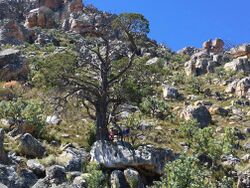Biology:Widdringtonia wallichii
| Widdringtonia wallichii | |
|---|---|

| |
| Scientific classification | |
| Kingdom: | Plantae |
| Clade: | Tracheophytes |
| Clade: | Gymnospermae |
| Division: | Pinophyta |
| Class: | Pinopsida |
| Order: | Cupressales |
| Family: | Cupressaceae |
| Genus: | Widdringtonia |
| Species: | W. wallichii
|
| Binomial name | |
| Widdringtonia wallichii | |
| Synonyms[2] | |
| |
Widdringtonia wallichii, Clanwilliam cedar or Clanwilliam cypress, previously Widdringtonia cedarbergensis[3][4] is a species of Widdringtonia native to South Africa , where it is endemic to the Cederberg Mountains northeast of Cape Town in Western Cape Province. It is threatened by habitat loss[5][6][7] and protected in South Africa under the National Forest Act (Act 84) of 1998.[8]
It is a small evergreen tree growing to 5–7 m (rarely to 20 m) tall. The leaves are scale-like, 1.5 mm long and 1 mm broad on small shoots, up to 15 mm long on strong-growing shoots, and arranged in opposite decussate pairs. The cones are globose to rectangular, 2–3 cm long, with four scales.[5]
Chemical constituents
The essential oil derived from leaves contains terpinen-4-ol (36.0%), sabinene (19.2%), γ-terpinene (10.4%), α-terpinene (5.5%) and myrcene (5.5%).[9] The wood oil contains thujopsene (47.1%), α-cedrol (10.7%), widdrol (8.5%) and cuparene (4.0%).[9]
References
- ↑ Farjon, A.; February, E.; Higgins, S.; Fox, S.; Raimondo, D. (2013). "Widdringtonia cedarbergensis". IUCN Red List of Threatened Species 2013: e.T30365A2793077. doi:10.2305/IUCN.UK.2013-1.RLTS.T30365A2793077.en. https://www.iucnredlist.org/species/30365/2793077.
- ↑ The Plant List: A Working List of All Plant Species, http://www.theplantlist.org/tpl1.1/record/kew-2466623, retrieved 14 May 2017
- ↑ "Widdringtonia cedarbergensis". PlantZAfrica.com. http://www.plantzafrica.com/plantwxyz/widcedar.htm.
- ↑ University of the Witwatersrand: Recommended English names for trees of Southern Africa
- ↑ 5.0 5.1 Farjon, A. (2005). Monograph of Cupressaceae and Sciadopitys. Royal Botanic Gardens, Kew. ISBN:1-84246-068-4
- ↑ Farjon, A.; February, E.; Higgins, S.; Fox, S.; Raimondo, D. (2013). "Widdringtonia cedarbergensis". IUCN Red List of Threatened Species 2013: e.T30365A2793077. doi:10.2305/IUCN.UK.2013-1.RLTS.T30365A2793077.en. https://www.iucnredlist.org/species/30365/2793077. Retrieved 16 November 2021.
- ↑ Pauw, C. A. & Linder, H. P. 1997. Widdringtonia systematics, ecology and conservation status. Bot. J. Linn. Soc. 123: 297-319.
- ↑ "Protected Trees". Department of Water Affairs and Forestry, Republic of South Africa. 30 June 2013. http://www2.dwaf.gov.za/dwaf/cmsdocs/4116___poster%20protected%20trees.pdf.
- ↑ 9.0 9.1 Kamatou, G.P.P.; Viljoen, A.M.; Özek, T.; Başer, K.H.C. (2010). "Chemical composition of the wood and leaf oils from the "Clanwilliam Cedar" (Widdringtonia cedarbergensis J.A. Marsh): A critically endangered species". South African Journal of Botany 76 (4): 652. doi:10.1016/j.sajb.2010.04.002.
- "Widdringtonia cedarbergensis". PlantZAfrica.com. http://www.plantzafrica.com/plantwxyz/widcedar.htm.
Wikidata ☰ Q17275235 entry
 |


